Compulsory Modules
|
Applied Environmental Statistics |
|||
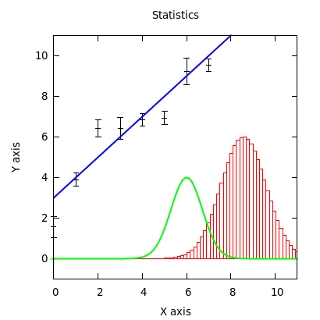 |
Module coordinator
|
||
| Statistics and computer-based data analysis are a basic tool for any empirical science today, and especially forestry, where extensive data are necessary to describe forest characteristics. | |||
SyllabusIntroduction to statistical methods:
|
|||
Learning goals and qualificationsAt the completion of the course the students should be able to design experiments and analyse data from these experiments with standard statistical analysis programs. Major emphasis is placed on the prerequisites for using the methods and on the interpretation of the results. |
|||
Teaching and learning methodsLectures, computer exercises, e-learning module on statistics |
|||
Ecosystem Management |
|||||||||||
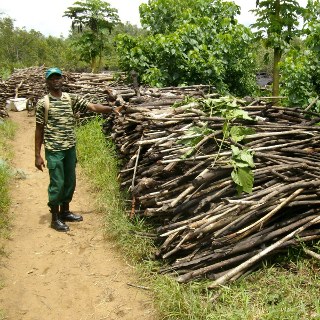 |
Module coordinator
Additional Lecturers
|
||||||||||
| Illegally exploited mangroves in the Douala-Edea Wildife Reserve, Cameroun. In protected areas where locals need natural resources for their livelihoods, ecosystem management is a real challenge (FEM internship 2009) | |||||||||||
SyllabusThe concept of Ecosystem Management has merged as a new paradigm for the management of natural resources. It is based on the objectives of sustainable use and conservation of natural resources as well as fair and equitable sharing of benefits from ecosystem goods and services. Underpinning this approach are explicit objectives for the management of natural resources that can be translated into measurable goals, which lend themselves to monitoring. Ecosystem management recognises that ecosystems are complex and interconnected systems, which function on a range of spatial and temporal scales. While management should be based on sound ecological models and understanding aiming at maintaining ecosystem integrity, the approach acknowledges that knowledge on ecosystems is limited and the paradigms provisional and likely to change in future. Consequently management approaches are being viewed as hypotheses that require testing through systematic research and monitoring resulting in adaptive management. |
|||||||||||
Learning goals and qualificationsIn this module students learn to:
|
|||||||||||
Core readingsA list of relevant texts will be made available at the start of the course; obligatory readings (and part of the voluntary readings) will be made available online in electronic form. Preliminary readings:
|
|||||||||||
Teaching and learning methodsLectures, excursions, tutorials, independent learning |
|||||||||||
Requirements for registrationStudents need to bring their passports on the excursion, and should be vaccinated against ticks and tetanus. |
|||||||||||
Forest Resources and Wood Production |
|||||||||
 |
Module coordinator
Additional Lecturers
|
||||||||
| Portable sawmill of the Forest Utilization Institute. Students have the chance to see and evaluate the effect of wood properties on later processing. | |||||||||
SyllabusThe main driver of forestry today is the value of wood as a renewable natural resource. While most of the modules in the FEM program are oriented towards an ecological conception of forests, this module focuses on the forests worldwide as an exploitable resource. The module presents the state of the forest resources today, as well as trends and causes for these trends. What is the production potential of different forest types and what is the current use of forest resources in different regions of the world. Quality criteria for timber are introduced and management options oriented towards wood production are presented, as well as their impact in wood quantity and quality and in the future scenarios concerning world forests (natural forests, semi-natural forests, devastated secondary forests, man-made forests). The module includes a section about forest utilization: harvesting and transport methods and their dependence on management options, accessibility of timber resources, wood processing, etc. |
|||||||||
Learning goals and qualificationsStudents will gain knowledge
Students will acquire competence:
|
|||||||||
Teaching and learning methodsLectures, tutorials, panel discussions, group works, excursions |
|||||||||
Global Environmental Changes |
|||||
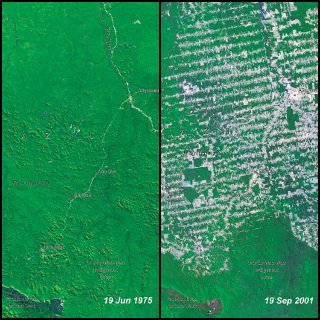 |
Module coordinators
Additional Lecturers
Joint with MEG |
||||
| Satellite image showing deforestation in the Amazonian bassin, Brazil. Left: 1975. Right: 2001. (Source: UNEP) | |||||
SyllabusStudents will be introduced to some of the globally most important environmental problems such as water and air pollution, acid rain and forest decline, the loss of forests and biodiversity, global warming and others. At the same time, this module is designed to familiarise students with the research process in the environmental and social sciences. Based on selected reading, partly from the book “The sceptical environmentalist” (Lomborg 2001) and the responses from other scientists to its author’s arguments, students will be challenged by the difficulty to assess the magnitude of environmental problems. Against this background, research ethics, the quality and reliability of scientific information, and the role of science in the public discourse will be discussed. Following the introduction of particular environmental problems by experts, students will work in groups to examine independently the extent of these problems in more depth and analyse the, sometimes contrasting, claims and arguments made by different scientists. |
|||||
Learning goals and qualificationsIn this module students are expected:
Development of the following qualifications is supported:
|
|||||
Teaching and learning methodsLectures, tutorials, discussion groups, independent research |
|||||
Preliminary Readings
|
|||||
Managing Human-Environment Interactions |
|||||
 |
Module coordinator
Additional Lecturers
Joint with MEG
|
||||
|
Fire is socially conceived as highly destructive for forests, yet research has shown that it plays an important role in some forested ecosystems. As a driving factor for action, societal values and dynamics have to be considered in parallel with scientific knowledge for adequate environmental management
|
|||||
SyllabusAll people live within an environmental context and all societies have developed ways of managing their interactions with their environment. This course explores the various ways in which societies organize and manage relationships with their environmental context and their use and appreciation of natural resources. Social institutions can take many forms: rituals, traditions, informal practices, and formalized procedures. While the disciplines for understanding people, economies, and ecological processes tend not to consider the context of action, a management perspective requires contextual analysis and understanding. This module links analysis of people, politics, markets, and ecosystems by examining the institutions and ideas connecting them. In the first part, this course will focus primarily on the social institution of “property”; in the second part it will deal with various “classical” conceptual frameworks of environmental management – which will be deconstructed using a paradigm’s perspective. |
|||||
Learning goals and qualificationsIn this module students are expected:
|
|||||
Teaching and learning methods
Students will have a core set of readings to introduce them to the main institutions for managing human environment interactions. Student teams will examine different institutions in more depth and give presentations to the class. Classes will be a mix of lecture and discussion where students have prepared the readings in advance. In addition, this module will have team projects in which students elaborate property rights regimes for different types of natural resources and in which they review “classical” conceptual frameworks of environmental management.
|
|||||
Methods in Ecosystem Analysis |
|||||||||||||||
 |
Module coordinators
Additional Lecturers
|
||||||||||||||
SyllabusThis module focuses on the theory of experimentation and the practical application of a set of different approaches and methods to address questions in ecosystem analysis. In this module students will be given the opportunity to learn methods required in their MSc research. In addition, students will get familiar with fundamental concepts in experimentation such as accuracy, replication, reproducibility, documentation etc. Following a general introduction to the principles of experimental design and analysis, students will work in small groups. These groups will learn research methods in the following areas:
In each of these areas, students will collect samples or data using a range of methods, analyse samples were applicable (in the field or the laboratory), and compile, screen, analyse and interpret data, to allow a critical appraisal of the whole process. |
|||||||||||||||
Learning goals and qualificationsStudents will learn:
Classification of cognitive skills following Anderson & Krathwohl (2001): 1 = Remember: retrieving relevant knowledge from long term memory; 2 = Understand: determining the meaning of instructional messages (interpreting, exemplifying, summarizing ...); 3 = Apply: carrying out or using a procedure in a given situation; 4 = Analyze: breaking material into its constituent parts and detecting how the parts relate to one another and to an overall structure or purpose; 5 = Evaluate: making judgment based on criteria and standards; 6 = Create: putting elements together to form a novel, coherent whole or make an original product. |
|||||||||||||||
Core readingsA list of relevant texts will be made available at the start of the course; obligatory readings (and part of the voluntary readings) will be made available online in electronic form. Teaching and learning methodsLectures, practical exercises, field and lab work, tutorials, peer review |
|||||||||||||||
Natural Hazards and Risk Management |
|||||||||||
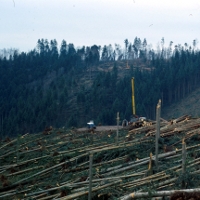 |
Module coordinator
Additional Lecturers
|
||||||||||
| The winter-storm “Lothar” on the 26th of December 1999 caused more than 40 million m3 of storm damage in South-West Germany. | |||||||||||
Syllabus
Almost every day we are confronted with news of natural catastrophes, the spread of diseases and other disturbances, which are all events that affect both natural and managed ecosystems. To manage ecosystems sustainably, these risk factors need to be considered. This module will introduce students to a range of biotic and abiotic risk factors and the way in which these may affect ecosystems and the enterprises depending on them. In addition, students will learn about the components of ecosystem resistance and resilience and how these can be managed to stabilise forest ecosystems and reduce the impact of risks. Particular emphasis will be placed on the following ecosystem risks/disturbance agents: storms, fire, and biotic factors such as pests and diseases. Students will learn that disturbances are a normal phenomenon in ecosystems and responsible for the dynamics of stands and landscapes. The importance of managing ecosystems within the variation of a natural disturbance regime will be discussed, and approaches to assess disturbance regimes will be examined. Examples of ecosystem risks and disturbances and how they can be considered in natural resource management will be drawn from around the world. Risk management and particularly risk assessment and risk modelling will be a focus of the module. Based on a case study of a forest enterprise heavily damaged by a severe storm event, students learn how to assess and evaluate the damage using real world data and prioritize necessary actions to deal with catastrophic disturbances by setting up a Gantt-chart and a detailed risk management plan.
|
|||||||||||
Learning goals and qualificationsStudents will learn:
|
|||||||||||
Teaching and learning methodsLectures, tutorials, pracs, excursions |
|||||||||||
Preliminary Readings
|
|||||||||||
Population and Community Ecology |
|||||||
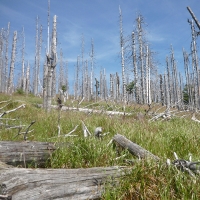 |
Module coordinator
Additional Lecturers
|
||||||
| Effects of bark beetle in a spruce forest at the Bavarian Forest National Park. Insect populations can have a devastating effects on forest, and understanding their dynamics is key for appropriate management (FEM excursion to the Bavarian Forest National Park, 2009) | |||||||
SyllabusIn addition to individuals, populations and communities are important ecological entities. Plant species associating on certain sites form plant communities, which in turn, provide the basis for animal communities. Shifts in site conditions or successions result in a gradual turnover of species occurrences, both in plants and animals, that are linked in multiple and complex ways. Ecosystem management is based, in part, on population management by enhancement or suppression, respectively. Management goals include harvesting, conservation, and control of populations. Basic principles of population dynamics (biotic as well as abiotic factors) are significant for the understanding of various types of population dynamics. Some contexts are particularly highlighted because different factors have different impact according to species or management context:
|
|||||||
Learning goals and qualificationsIn this module students learn and study biological basics of populations and communities such as structure, dynamics, and determining factors. Major objective is to understand relationships between pedology, climatology, species compositions; the formation of plant and animal communities and populations, their ecological function, the relations among animals and between plants and animals. Furthermore, cases are presented and analysed to understand complexity of biotic and abiotic influences. Since every single problem of managing populations is unique; case studies are used to develop general principles and concepts that can be transferred to analyse any case for identifying biological factors crucial for management approaches. Students will be enabled to develop and implement adapted concepts and to consider and synthesize information from other sources (literature, modules). |
|||||||
Teaching and learning methodsLectures, tutorials |
|||||||
Preliminary Readings
|
|||||||
Soil Ecology and Management |
|||||
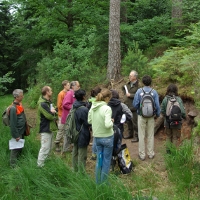 |
Module coordinator
|
||||
| Soil profile at the southern Black Forest. The area around Freiburg is extremely diverse in terms of soil types: soils typical from the boreal forests and other usually found in mediterranean areas can be found here in a range of 100 km. (FEM excursion, 2010) | |||||
SyllabusSoil assessment and mapping:
Soil hazards and soil protection:
Plant/Soil Relations:
|
|||||
Learning goals and qualifications
|
|||||
Teaching and learning methodsLectures (field and lecture hall), computer based training, field training |
|||||
Spatial Information Systems and Eco-Informatics |
|||||
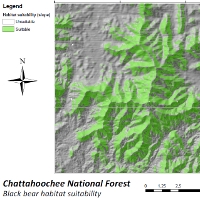 |
Module coordinator
Additional Lecturers
|
||||
| GIS computer programs provide powerful ways to integrate quantitative data on a spatial layout. | |||||
SyllabusLandscapes are dynamic, constantly and simultaneously affected by numerous processes. Major changes to the landscape can be caused by natural disasters, such as storms, fire, drought and flooding, whereas more gradual changes can be caused by weathering, wind, waves, frost, etc. To understand, monitor and react to these complex changes and processes, data must be collected, organised, managed, analysed and displayed. Since changes take place over such a large area, remotely sensed data is collected and managed with further data in a Geographical Information System (GIS). |
|||||
Learning goals and qualificationsStudents will acquire:
|
|||||
Teaching and learning methodsLectures, practical training, independent learning |
|||||
Tree Structure and Function |
|||||||||||
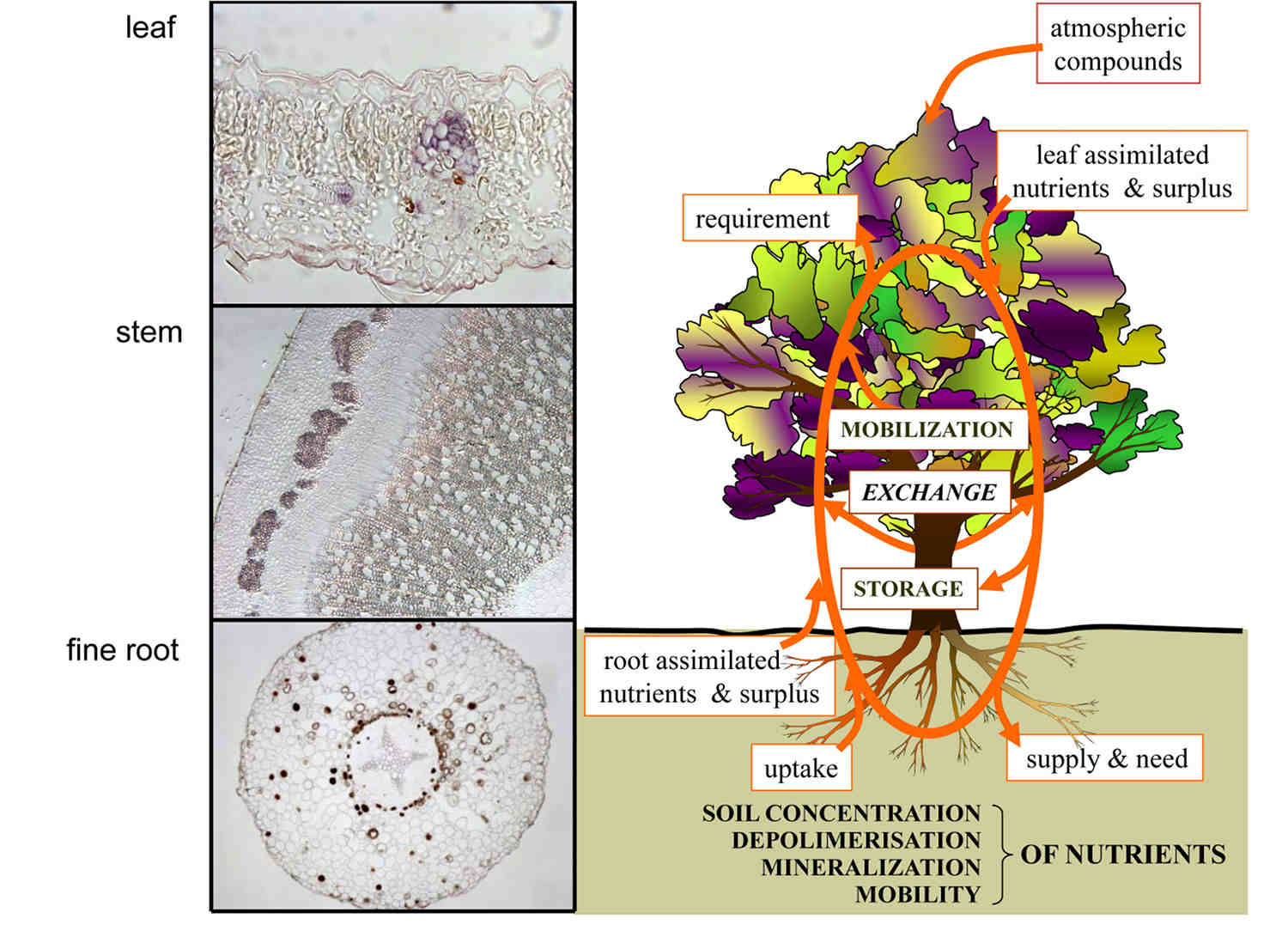 |
Module coordinators
Additional Lecturers
|
||||||||||
SyllabusThe module is a combination of plant structure and plant physiology; thus each part is separated into one part presenting the anatomy and a second part the physiology.
|
|||||||||||
Learning goals and qualifications
The students will:
|
|||||||||||
Teaching and learning methodsLectures, tutorials |
|||||||||||
Preliminary Readings
|
|||||||||||

